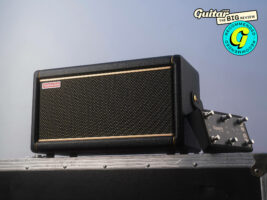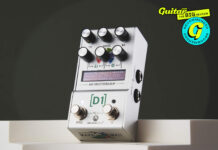
Positive Grid Spark 2 review – louder, smarter and better than ever
$299/£279, positivegrid.com
I remember Guitar.com checking out the original Positive Grid Spark amp at the January 2020 NAMM Show, and even amidst the chaos and din of the Anaheim Convention Center show floor, it was apparent that this would be something altogether more impactful and interesting than the brand’s previous foray into amps – the expensive if impressive BIAS Head.
READ MORE: Best practice amp solutions for all styles and budgets – from combos to headphone amps
Of course, none of us realised quite how impactful this lunchbox-sized practice amp would become over the following months. You may remember that we all spent a fair bit of time stuck in doors with not a lot to do over the following year or two. And once PG managed to navigate the supply chain issues and delays that the pandemic caused, guitarists of every stripe started championing the revolutionary qualities of the Spark, and it promptly reset the benchmark for what a home amp could do. In truth, everyone else has been playing catch-up ever since – on my last visit to the NAMM Show back in January, I couldn’t help but notice a few other amp brands were now touting their own ‘smart amps’, itself a category that didn’t exist until Positive Grid invented it.
In the years since the Spark has got smaller and smaller, and then bigger, and even picked up some megastar endorsements along the way. Since my first encounter with the Spark, I’ve spent the last couple of years advising anyone who asks me for a home amp recommendation to try one, and I’ve not had one person regret it.
Still, if you’re not moving you’re going backwards, and after four years Positive Grid has revisited the OG Spark and given it a major overhaul that promises to ensure that the brand remains at the top of the tree – let’s dive in.
The Spark 2’s control panel. Image: Adam Gasson
How does the Spark 2 differ from the Spark 1?
To look at it, the Spark 2 doesn’t cosmetically seem to have changed much compared to the original – it has the same long-and-narrow desktop-friendly form factor, the same black and gold covering and a nigh-identical basketweave grille covering its two four-inch speakers.
But appearances can be very deceiving – under the hood the Spark has changed dramatically. Let’s talk about those speakers – the original pair of drivers in the Spark 40 (what the original Spark was christened retrospectively) has evolved into a new angled pair with custom angled horn to improve the three-dimensional nature of the time-based sounds, while there are now two bass reflex ports as opposed to one on the original. The power level has also been upped here from 40 watts to 50 – giving you more volume and headroom to play with.
The control panel on top has also been completely redesigned to reflect the increasing integration with PG’s hugely impressive Spark app (more on that later). So instead of the 40’s amp-model selection rotary and four preset buttons – on reflection something that felt a little much like an old modelling amp hangover – we now have a rotary switch similar to the MINI that allows you to select from up to eight different sonic presets.
The Spark 2 and Control X. Image: Adam Gasson
As with the 40, the Spark 2 offers an increased level of on-amp tweakability than there was room for on the smaller Sparks. This means that you can tweak the gain, master volume and EQ of your amp sound without needing to get out your phone, and there’s also controls to alter the level of any modulation, delay or reverb effects you might have in your preset chain. You also get an overall volume control for both the guitar and any music you’re streaming to the thing via Bluetooth, but the rest of the top panel is devoted to the biggest, and most requested, addition to the Spark 2 – an onboard looper. You either get 60 seconds of looping time in count-in mode (where you hit record and it gives you a one-bar count before recording) or a free amount of time in on-signal mode – which starts recording as soon as it detects you playing.
But that’s not all, we also get an onboard LED tuner, plus stereo outs on the back and wifi connectivity for over the air updates. You get the same 33 amp models and 43 effects as the other Spark amps – albeit overhauled with new HD modelling – and they all play well with an overhauled Spark app, which adds a creative Groove Looper, and a new feature called Spark AI…
Oh and as if that wasn’t enough, the Spark 2 is now optionally portable if you want it to be. There’s a slot in the bottom of the amp to take the same $79 Spark Battery pack which will allow you to take full advantage of the leather carry handle and get up to eight hours of untethered playtime.
The Spark 2’s handle. Image: Adam Gasson
Is the Spark 2 easy to use?
The worst kind of ‘connected’ guitar product is the kind that obliges you to spend even more time scrolling through your phone when you should be playing, and as with every Spark amp, the most impressive thing about the Spark 2 is that you don’t need to boot up the app to have a good time – just turn on, plug in, and start having fun tweaking the parameters of the eight out of the box sounds to taste.
That would be something of a waste however, as the Spark app is where so much of the good stuff can be found. While so many connected guitar products fall down on the whole ‘actually connecting’ part, a quick press of the pair button on the back of the amp and within seconds the Spark 2 is paired and I’m able to go in and start tweaking the presets to my personal preferences – but there’s plenty more fun to be had here.
Almost since the start there have been calls for the Spark to add a looper function, and the Spark 2 doesn’t just give you one looper, it has two. So you have the basic simple looper that can be controlled on the amp or via the Spark app, which works perfectly well and does exactly what most guitar loop functions do – I won’t bore you with the details in that regard. However, also on the Spark app is a new function called ‘Groove Looper’, which allows you to add a drum beat to your loops. What’s really impressive is the level of control you have – you can select from dozens of different styles of beats, and you can also tweak the tempo and duration. There’s also a simple mixer built into the looper that allows you to set the level of guitar and drums to taste. It’s a really intuitive and simple to use thing that really enhances your loops without leaving you stuck endlessly tweaking.
Elsewhere on the app is another interesting new feature ‘Spark AI’. Now, I know what you’re thinking – I too am fed up of hearing about how AI is going to save the world while all it actually seems to be doing is making the internet worse and killing the planet all while committing industrial scale larceny of creative work.
Spark AI, thankfully, doesn’t seem to do any of that – instead it acts as a smart search engine for guitar tones. So, instead of spending hours flicking through amp and pedal combos to find the right one, you can simply ask Spark AI for the sort of tone you’re looking for, and it’ll provide you with four options to choose from that it thinks will do the job.
The tech is in beta right now and I’m using a pre-production Spark 2 model, and it’s not perfect yet – particularly when asking for artist-specific sounds – but most of the time one of the examples it suggested was pretty bang on with what I wanted.
It’s another example of what the Spark has always done so well – streamlining the option paralysis that bogs down so many modelling solutions, so you can spend more time playing.
Positive Grid were also good enough to supply me with a sample of the new Control X bluetooth foot controllers that launched back in January – this thing is a huge upgrade to the original Spark Control wireless foot controller that launched a few years back.
With six programmable switches, multi-colour LEDs and the ability to add two external expression pedals, whether you’re in preset or stompbox mode, I found it hugely enhances the overall Spark experience – though at $149 it’s something of a luxury addition.
The Spark Control X. Image: Adam Gasson
Does the Spark 2 sound good?
The Spark 2 boasts twice the processing power of its predecessor and you’d expect that to be audible in these new HD amp models – but the original Spark sounds were pretty great right, how good can they be?
Well, it turns out, really bloody good actually. The new HD models, combined with the extra headroom and power on tap and that extra bass port mean that the Spark 2 feels even more alive and entrancing than its predecessors. It feels even more like a ‘proper’ amp than the Spark 40, and once again the impressive part is how consistently good the amp’s hugely varied tones sound. With a flick of the preset knob you can go from a wonderfully lush and ethereal clean tone with lashings of reverb and delay, to a punishing and endlessly saturated metal distortion and they both sound not just good, but real. The extra wattage means that you can really turn the wick up and there’s very little compression (unless you want it) or the sense that the speakers are struggling to keep up (which can be the case at the extreme reaches of the Spark MINI for example). Instead it continues to offer full, meaty, feel-it-in-your-chest tones all the way up – you wouldn’t want to gig it, but if you’re home alone and want to give your eardrums some punishment, it’s quite shockingly loud for something that’s roughly the size of a loaf of bread.
Should I buy a Positive Grid Spark 2?
The Spark 2 obviously benefits from having four years of Positive Grid’s development and refinement of the concept, but there’s more to it than that. It also has the freedom of being part of a whole ecosystem now. Back in 2020 the Spark had to try and be all things to all people, but now if you want a Spark you can gig, well there’s the Spark Live, if you want one that you can chuck in a gigbag, there’s the Spark GO, if you want a stripped down portable practice amp, there’s the Spark MINI.
All of which means that the Spark 2 can focus on being its own distinct and focused thing now – a serious home and recording amp for serious players. The tones on offer are better than ever, the option to make it portable a nice (if not cheap) addition, and the new looping and creative options through the app once again show that Positive Grid gets what players want from a home amp, and importantly what they don’t.
Don’t let appearances deceive you – the Spark 2 is more than just an iterative update, it’s the most essential Spark yet.
Positive Grid Spark 2 alternatives
Most of the Spark’s competitors are, well, also Spark amps! I still think the Spark MINI hits the perfect balance between features, sound and portability – and it’s a bargain too. Four years on and some of PG’s competitors are getting in on the action too, with Mooer’s SD30i, ahem, ‘Intelligent Amp’ perhaps the most notable. If this app-based stuff seems like a bit much, you could do a lot worse than Line 6’s POD Express – a simple, compact, headphone amp with some basic but impressive sounds.
The post Positive Grid Spark 2 review – louder, smarter and better than ever appeared first on Guitar.com | All Things Guitar.
Source: www.guitar-bass.net










